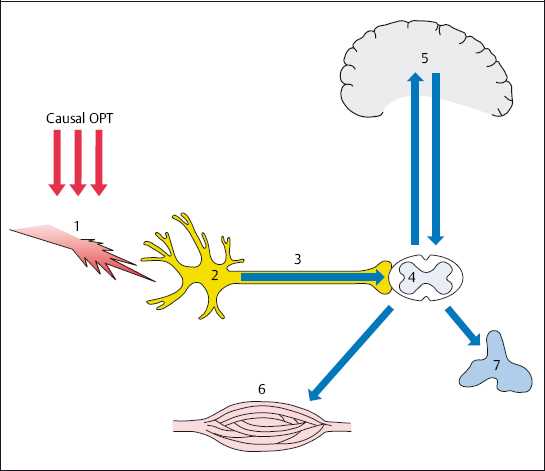The methods used in the causal treatment of spinal pain are basically the same as those used in conservative orthopedic treatment, but with a different emphasis. The primary aim of causal pain treatment is to reduce pain stimuli, reducing nociception or preventing it altogether in the bones, muscles, and joints (Fig. 3.1, Table 3.1). Initial treatment relies on methods that are immediately available, such as positioning, orthopedic aids, and manual therapy. These are followed up by long-term measures such as postural and behavioral training (back school), physical therapy, and an exercise program.
| Positioning, traction |
| Orthopedic aids |
| Manual therapy |
| Physical therapy |
| Postural and behavioral training; back school |

Fig. 3.1 Causal orthopedic pain therapy (OPT): Site of action, reduction, or neutralization of noxious stimuli that initiate or maintain nociception.
Positioning and Traction
Each painful section of the skeleton has a certain position that minimizes the amount of pain. The position-dependence of the pain is therefore an important diagnostic criterion.
Pain originating in the spine is generally relieved when the affected spinal segment is flexed. Flexion (increasing the kyphosis) causes the intervertebral foramen to open up, relaxes the vertebral joint capsule, and flattens out disk protrusions, in every segment of the spine (see Chapter 5).
When lying supine or on one side, the patient can attain this position by flexing the knees and hips. When standing, the trunk and neck are flexed and a flexion orthosis may be used. A sitting position requires the upper body to be supported and the knees placed lower or higher, depending on the body’s posture.
The spine can be further relieved when positioning is combined with the use of traction. As well as the therapeutic forms of traction usually carried out by physiotherapists, patients can be given helpful information about self-traction, the use of gait aids, or traction braces for the lumbar spine.
Orthopedic Aids
The temporary or permanent use of orthopedic aids plays a significant role in relieving acute and chronic pain in the spine and the musculoskeletal system generally, and reduces the consumption of analgesics. Orthopedic aids include splints, braces, and shoe adjustments, as well as positioning aids such as an adapted foam cube to rest the legs on when lying supine or Glisson traction on the cervical spine. Within the scope of orthopedic pain therapy, orthopedic aids are used for:
- Immobilization, partially or fully limiting spinal movement. The amount of movement available in spinal segments can be limited to the range that causes the least amount of pain, and ranges that provoke pain can be blocked.
- Reduction of weight-bearing: Reducing the load applied to the damaged part of the musculoskeletal system has a long-term influence on chronic pain.
Aids that limit painful ranges of movement and also reduce the load on damaged parts include the various types of trunk orthoses used to reduce pain in the presence of conditions such as osteoporotic compression fractures of the vertebrae, disk protrusion, spondylitis, or tumors. The use of correctly fitted trunk orthotics dramatically reduces the consumption of analgesics in these sometimes very painful disorders.
Manual Therapy
In manual therapy the hands are used to treat reversible painful functional musculoskeletal disorders. Painful hypo- or hypermobility in individual joints or groups of joints is noted by the practitioner. According to the results of the assessment, joints can then be either mobilized or stabilized by the use of exercises.
NOTE
The return to normal function using manual therapy is an example of causal pain therapy.
The aim of mobilization is to regain the original mobility of a joint using slow movements and large-amplitude oscillations. Joint manipulation, on the other hand, involves first of all moving the joint as far as possible within the pain-free range, then delivering a quick, short impulse to overcome the barriers without traumatizing tissue. A cracking sound may be heard.
The analgesic effect of manual therapy mobilization and manipulation results from the easing of joint capsule tension. This eliminates the cause of pain. Treating joint malpositioning and painful capsular tension with medication alone is purely symptomatic and temporary.
Physical Therapy
Physical therapy is a form of movement therapy that requires a doctor’s referral in some countries. Special assessment and treatment techniques are used for the treatment of developmental disorders, injuries, secondary disorders arising from injuries, and disorders affecting organic and psychological functioning. Physical therapy essentially deals with healing through movement.
Physical therapy and movement therapy are used to facilitate the healing process in joints, muscles, tendons, ligaments, and bones. Generally speaking, this form of therapy addresses pain indirectly.
Physical therapy works causally by muscle strengthening and the reduction of muscular imbalances. Chronic pain originates mainly in the inferior cervical spine and the lumbar spine, but can also come from the muscular attachments in the pelvis and in the anterior knee. It is wise to treat these muscular imbalances with abdominal muscle strengthening, stretching of the hamstrings, and exercises, rather than with pain medication. Analgesics are at best used initially so that the patient is willing to do the exercises.
There are many reasons for the use of physical therapy in symptomatic pain therapy. Specific movements ensure the removal of inflammatory mediators surrounding the nociceptors and the nerves that have developed into nociceptors. Movement stimulates the blood flow and helps to reduce autonomic reactions and muscle spasms (Fig. 3.2).
Different forms of movement therapy have been developed to address orthopedic pain symptoms that involve high muscle tension and excessive adaptive postures. They utilize the body’s own reflexes and the physiological behavior of nerves and muscles. In proprioceptive neuromuscular facilitation (PNF) the patient follows a specific pattern of movement against a suitably adjusted resistance while the proprioceptors are stimulated. As a result, the muscular response increases in the presence of muscle imbalances.









